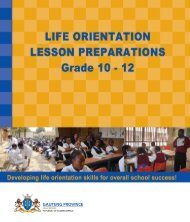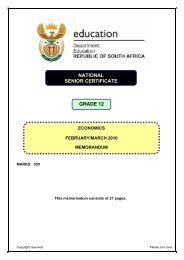Life Science Grade 11
Life Science Grade 11
Life Science Grade 11
You also want an ePaper? Increase the reach of your titles
YUMPU automatically turns print PDFs into web optimized ePapers that Google loves.
<strong>Grade</strong> <strong>11</strong> <strong>Life</strong> <strong>Science</strong>s Lesson PlansGRADE <strong>11</strong> SUBJECT <strong>Life</strong> <strong>Science</strong>s WEEK 6 TOPIC Structure of Flowers (Practical) LESSON 3LESSON SUMMARY FOR: DATE STARTED:DATE COMPLETED:Content:• Wind pollinated, insect pollinated and bird pollinated flowers all have different structures• Dissection of one species of each type of differently pollinated flower will be examined and dissectedLESSON OBJECTIVESThe learners must be able to:• Work together in a group• Follow instructions• Record observations in a table• Identify the different structures of the flowers that are pollinated by different meansTEACHER ACTIVITIES LEARNER ACTIVITIES TIMING RESOURCES NEEDED1. Practical work: Structure of flowers that are pollinated by wind, insect and birds1.1 Introduction• Pre-knowledge: Use of hand lens and scalpels• Briefly go through safety rules in laboratory when handling apparatus and asklearners if any of them have any known allergies to pollen produced by theflowers being used2.2 Main Body (Lesson presentation)• Divide the learners into groups (not more than 6 per group)• Give learners the following instructions for observing the different types offlowers:• Examine the flowers from the outside by using the hand lens or the dissectingmicroscope• Use a reference diagram from your text book or teacher to help you• These observations need to be recorded in a comparative table• Your table should have the following headings in four columns: Feature, birdpollinateflower, insect- pollinated flower and wind- pollinated flower• Under feature record sepals (present or not and number), petals (number anddescription), stamens (number and arrangement), style (length and shape),stigma (number and position),and ovary (shape and position)• Make a labelled sketch of your flowers• Use the scalpel to cut your flower longitudinally• Using your forceps and scalpel if necessary, carefully remove the outer twowhorls of the flower• Examine them and count how many there are, recording your observations inyour table• Count the number of stamens present in your flower, recording the number inyour table, and carefully remove one of them• Examine the lobed structures at the tip of the stalk• The central most part of the flower is the pistil1. Group work:Following instructions,making observations in theform of a table2. Learners must draw a tablefor observations5 min20 min• Samples of each type of flower: windpollinated– E.g grass, Restios, insectpollinatedflowers E.g Daisy, hibiscus,black-eyed Susan, bird- pollinated E.galoe, Strelitzia• Sharp razor blade, scalpel• Hand lens or dissecting microscope• Forceps• Practical Ref:• Solutions for all <strong>Life</strong> <strong>Science</strong>s <strong>Grade</strong> <strong>11</strong> pp.74 - 75• Internet reference for practical work:http://www.nuffieldfoundation.org/practical-biology/comparing-flower-structuredifferent-angiospermsTerm 1 Page 50© Gauteng Department of Education (CAPS version)







